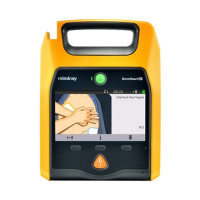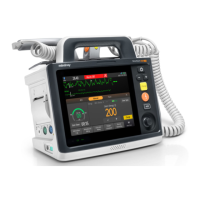Defibrillator/Monitor Operator’s Manual 12 - 5
12.7.4 Setting SpO
2
Sensitivity (for Mindray SpO
2
)
The SpO
2
value displayed on the screen is the average of data collected within a specific time. The shorter the
averaging time is, the quicker the equipment responds to changes in the patient’s oxygen saturation level, but
the measurement accuracy is relatively low. Contrarily, the longer the averaging time is, the slower the
equipment responds to changes in the patient’s oxygen saturation level, but the measurement accuracy will be
improved. When monitoring critically ill patients, selecting shorter averaging time will help understanding the
patient’s condition.
For Mindray SpO
2
module, you can set [Sensitivity] to [High], [Med] or [Low] from the [SpO2 Setup] menu,
which respectively correspond to 7 s, 9 s and 11 s.
12.7.5 Setting SpO
2
Sensitivity (for Masimo SpO
2
)
For Masimo SpO
2
module, you can set [Sensitivity] to [High], [Normal] or [APOD] from the [SpO2 Setup]
menu.
Normal sensitivity is the recommended for patients who are experiencing some compromise in blood flow or
perfusion. It is advisable for care areas where patients are observed frequently, such as the intensive care unit
(ICU).
Adaptive Probe Off Detection (APOD) sensitivity is the recommended sensitivity mode where there is a high
probability of the sensor becoming detached. It is also the suggested mode for care areas where patients are not
visually monitored continuously. This mode delivers enhanced protection against erroneous pulse rate and
arterial oxygen saturation readings when a sensor becomes inadvertently detached from a patient due to
excessive movement.
Maximum sensitivity is recommended for use on patients with weak signals (e.g. high ambient noise and/or
patients with very low perfusion) and for use during procedures or when clinician and patient contact is
continuous such as in higher acuity settings.
• When using the Maximum Sensitivity setting, performance of “SpO2 Sensor Off” detection may be
compromised. If the equipment and the sensor becomes detached from the patient, the potential
for false readings may occur due to environmental noise such as light, and vibration.
12.7.6 Changing Averaging Time (for Masimo SpO
2
)
The SpO
2
value displayed on the screen is the average of data collected within a specific time. The shorter the
averaging time is, the quicker the equipment responds to changes in the patient’s oxygen saturation level, but
the measurement accuracy is relatively low. Contrarily, the longer the averaging time is, the slower the
equipment responds to changes in the patient’s oxygen saturation level, but the measurement accuracy will be
improved. When monitoring critically ill patients, selecting shorter averaging time will help understanding the
patient’s condition.
For Masimo SpO
2
module, you can set [Average Time] to [2-4 s], [4-6 s], [8 s], [10 s], [12 s], [14 s] or [16 s] from
the [SpO2 Setup] menu.
12.7.7 Enabling FastSAT (for Masimo SpO
2
)
FastSAT enables rapid tracking of arterial oxygen saturation changes as may be required in urgent situations.
When FastSAT is switched on, the averaging algorithm evaluates all the SpO
2
values and provides an averaged
SpO
2
value that is a better representation of the patient’s current oxygen saturation status.
The reliability of FastSAT is dependent on the setting for the averaging time and the input signal. To enable
FastSAT, set [Fast SAT] to [On] from the [SpO2 Setup] menu.
12.7.8 Displaying SIQ (for Masimo SpO
2
)
The signal quality indicator (SIQ) displays below the Pleth waveform. The SIQ is conveyed by vertical bars. The
height of the bar provides an assessment of the confidence in the displayed SpO
2
value. The SpO
2
SIQ can also
be used to identify the occurrence of a patient ‘s pulse.
The following picture shows the SpO2 SIQ.

